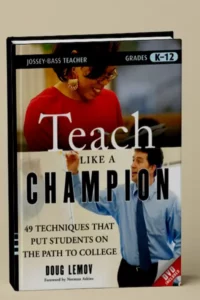Teach Like a Champion provides effective teaching techniques to help teachers, particularly those in their first few years, become classroom champions.
These powerful techniques are concrete, specific, and are easy to put into action the very next day. Training activities at the end of each chapter help the reader further their understanding through reflection and application of the ideas to their own practice.
HOW TO USE THIS BOOK
I’ve organized this collection of field notes from my observations of highly effective teachers as a how-to book and divided the techniques into two parts. Part One contains nine chapters that delve into the essential techniques I observed in the classrooms of exceptional teachers, those whose results are most clearly effective in ensuring outstanding achievement among even the high- est need students.
These teachers include many of the champions from within Uncommon Schools, the organization where I am a managing director, and many others from top schools around the country where I have had the privilege to observe.
The techniques are clustered into chapters organized into larger themes that are relevant to your teaching: raising academic and behavioral expectations, structuring lessons, creating a strong and vibrant student culture, and building character and trust.
The forty-nine techniques to which the book’s subtitle refers appear in the first seven chapters. Chapters Eight and Nine discuss two other critical issues in teaching, pacing and questioning.
The observations I’ve drawn from watching champions in these areas didn’t break down quite as cleanly into techniques so the observations in these chapters aren’t numbered. That said I believe you’ll find them just as useful.
Like all the material in this book, those chapters were derived from watching how champions do it. Part Two of the book focuses on critical skills and techniques for teaching reading. The structure of the book allows you to pick and choose techniques in order to improve and master specific aspects of your technique one at a time and in the order that best suits your teaching.
At the same time, the full array of techniques operates in synergy; using one makes another better, and the whole is greater than the sum of the parts. So I hope you will also find time to read the book through end-to-end and push yourself to refine some of the techniques you might not initially choose to focus on.
Alternatively, reading the book through cover- to-cover might help you understand more clearly where you want to develop, either because you have talent and strong instincts for a group of techniques or because you wish you did.
As you consider how to use this book, I offer one preliminary reflection on developing people, including yourself. It’s easy to slip into a “fixing what’s wrong” mind-set, with yourself and with others whom you’re developing or man- aging.
And while mitigating someone’s weaknesses, including your own, can be an effective development strategy, an alternative is to focus not on fixing what’s wrong but on maximizing and leveraging strengths.
This also applies to the excel- lent teachers I’ve observed in the course of my work: they too have weaknesses in their teaching, despite their often breathtaking results. What often makes them exceptionally successful are a core group of things they are exceptionally good at.
It’s plausible that developing what you’re already good at could improve your teaching just as much, if not more, than working on your weaknesses, though even more likely is that a combination of the two would yield the best outcomes.
Regardless, you might be tempted to skip a chapter because you are already good at the topic it discusses, but I encourage you to study that chapter with special attentiveness specifically because you are good it.
A bit of refinement in your technique could be something you quickly and intuitively apply and could make you exceptional—or more exceptional. In other words, invest in your strengths, too. Maximizing them can be as or more powerful than eliminating all of your weaknesses.


